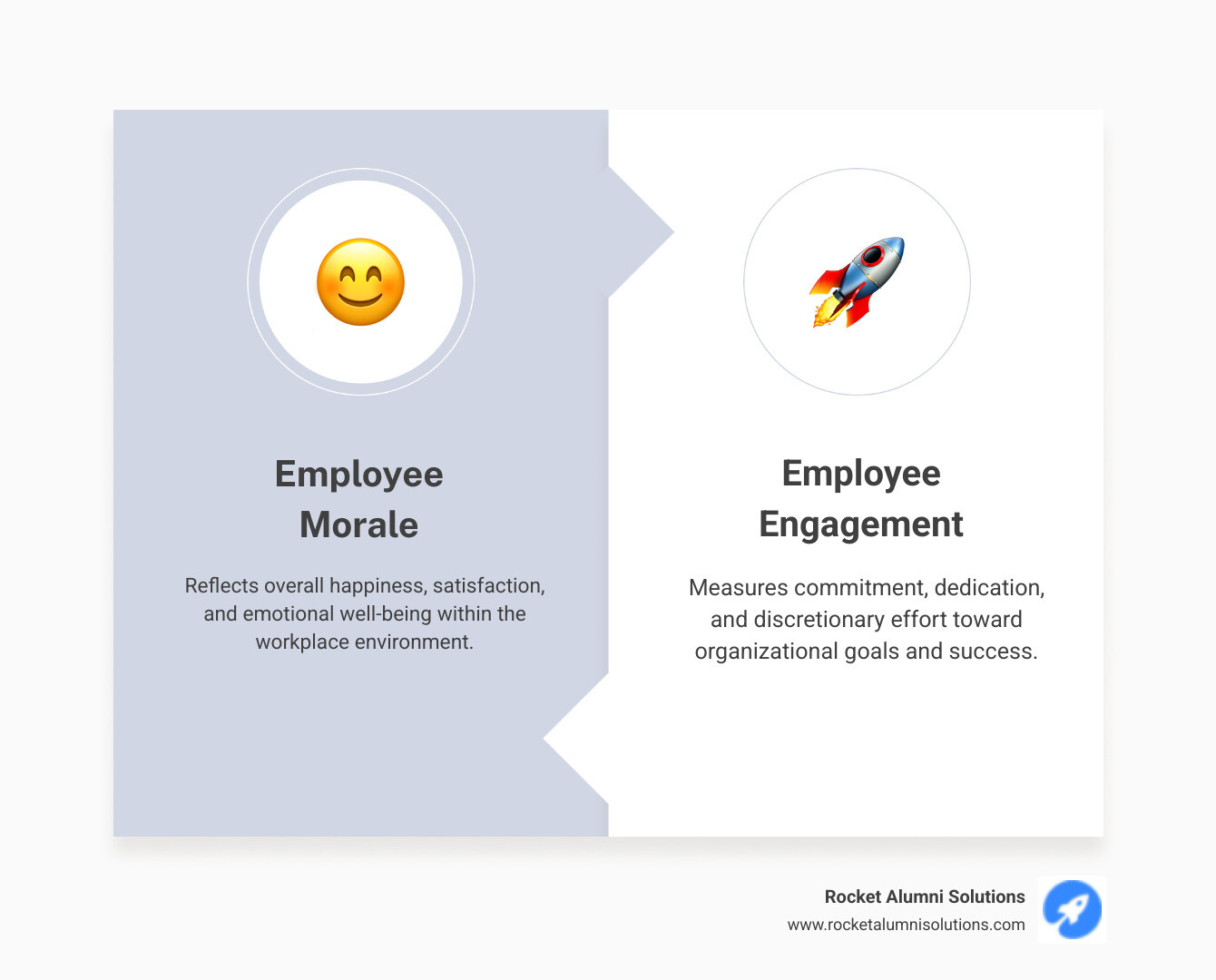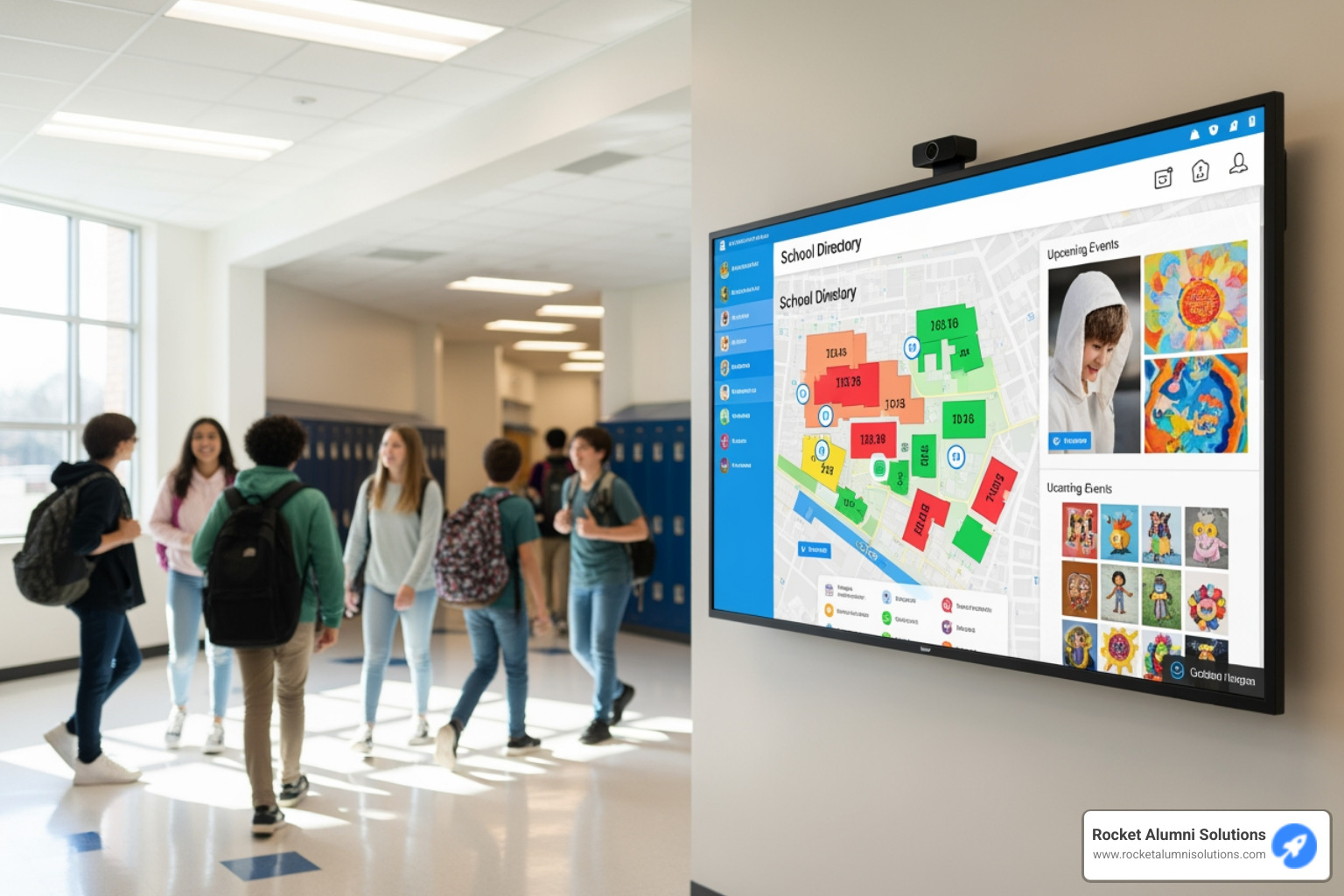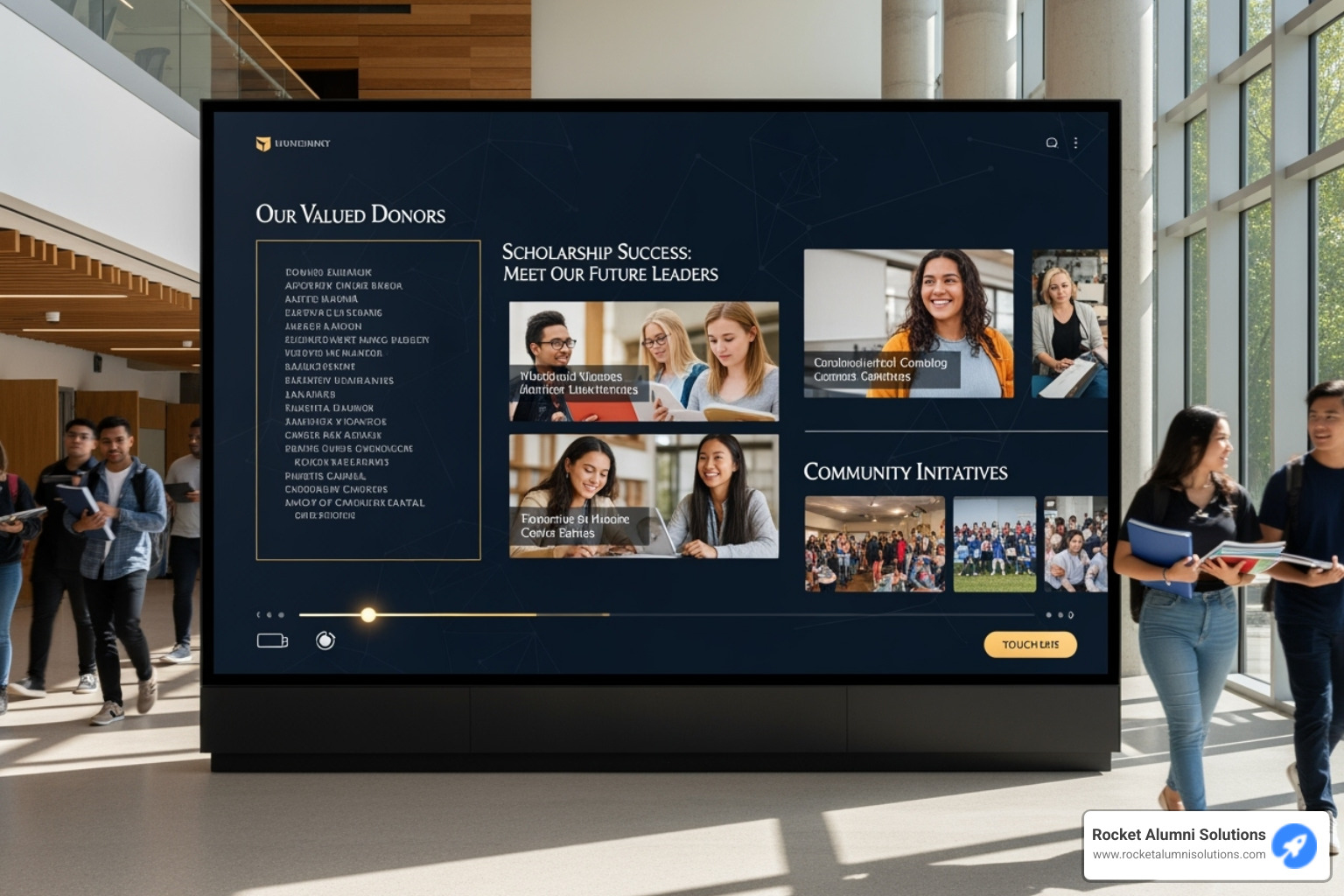The Power of Boosting Employee Morale and Engagement
Boosting employee morale and engagement is central to a successful and thriving workplace. It helps create a positive environment where people love their work. If you're looking to lift spirits and connect your team, here are key ways to improve morale and engagement:
- Foster open communication and transparency.
- Offer meaningful recognition and appreciation.
- Invest in employee growth and development.
- Support work-life balance and well-being.
- Create a sense of purpose and belonging.
Today, many workplaces face challenges. A large number of employees are "quietly quitting." This signals a big drop in employee morale and engagement. It costs organizations trillions of dollars globally.
But when companies focus on engagement, the results are clear. Productivity can jump by 18%, and profits can climb by 23%. High morale means employees are happier, more productive, and more likely to stay. It leads to better teamwork and new ideas.
As the Founder & CEO of Rocket Alumni Solutions, Chase McKee RAS has learned that cultivating genuine ownership and purpose is key to boosting employee morale and engagement. He has seen how fostering a vibrant culture through recognition and engagement leads to significant growth and loyalty.

Key boosting employee morale and engagement vocabulary:
The Foundation: Why a Positive Culture is Non-Negotiable
Before diving into specific strategies for boosting employee morale and engagement, we must establish a positive workplace culture. This culture is the bedrock of your organization, built on trust, open communication, and psychological safety. Without this foundation, any morale-boosting efforts can fail. Research from Harvard University’s Division of Continuing Education confirms that positive cultures lead to healthier, happier, and more productive employees who are less likely to leave. A great culture drives higher financial returns, making it a proven path to success.

The Manager's Critical Role in Fostering Engagement
Managers play a pivotal role in boosting employee morale and engagement, accounting for 70% of the variance in team engagement. They directly shape the employee experience. A great manager acts as a coach, not a micromanager, supporting their team and celebrating wins. The impact is clear: 56% of employees would refuse a 10% raise to stay with a great manager, while 82% would quit because of a bad one, according to a GoodHire survey.
Effective managers leverage emotional intelligence to develop their team's talents. Regular one-on-one meetings are crucial; 82% of employees with weekly one-on-ones feel supported, compared to 66% with less frequent check-ins. These meetings clarify expectations and remove roadblocks. To empower your managers, provide them with tools like our Employee Recognition Features, which simplify appreciation and help build a positive team vibe.
Cultivating Psychological Safety and Inclusivity
Psychological safety is essential for boosting employee morale and engagement. It's a workplace where employees feel safe to share ideas, admit mistakes, or challenge the status quo without fear. This safety encourages creativity, smart risk-taking, and innovation. It is closely linked to diversity, equity, inclusion, and belonging (DEIB). An inclusive culture, where everyone feels welcome to be authentic, leverages diverse perspectives for better problem-solving.
Conversely, Harvard research shows that toxic employees harm the bottom line. Addressing toxic behavior swiftly is crucial to maintaining a healthy, respectful environment where diverse views are celebrated. Learn more about how to Improve Workplace Culture.
Mastering Communication, Feedback, and Transparency
Clear, honest communication is the lifeblood of an engaged organization. When leaders are transparent, it builds trust. Employees need to understand company decisions and see how their work contributes to the bigger picture. An "open-door policy" must be supported by continuous dialogue and a commitment to acting on feedback.
Use tools like anonymous surveys, one-on-one check-ins, and "stay interviews" to gather invaluable insights. The key is not just to collect feedback but to act on it and close the feedback loop. Let employees know what changes were made based on their input. When people see their suggestions lead to improvements, it builds immense trust. As Gallup research shows, acting on feedback is what truly builds trust. For more strategies, learn How to Increase Employee Morale.
10 Actionable Strategies for Boosting Employee Morale and Engagement
Now that we've laid the groundwork for a truly positive company culture, it's time to roll up our sleeves! Let's explore some practical, proven strategies for boosting employee morale and engagement. These aren't just trendy ideas; they're actionable steps that can genuinely transform your workplace into a place where everyone loves to contribute.

1. Prioritize Meaningful Recognition and Appreciation
Appreciation is a fundamental human need and a powerful tool for boosting employee morale and engagement. Meaningful recognition makes team members feel seen and valued. In fact, 53% of employees stay longer if they feel appreciated, and 76% find peer praise highly motivating. This highlights the importance of both top-down and peer-to-peer appreciation. At Rocket Alumni Solutions, our digital solutions like Digital Appreciation Awards, the Interactive Employee Recognition Wall, and the Kudos Board, make it easy to celebrate achievements publicly and frequently, weaving recognition into your company culture.
2. Invest in Career Growth and Professional Development
A lack of growth opportunities is a primary reason employees leave, with 63% of workers citing it. Investing in professional development and career growth is a powerful way of boosting employee morale and engagement. Offer mentorship programs, learning opportunities like online courses, and create clear career paths. When employees see a future with your company, they become more engaged, motivated, and loyal. Empower them to learn and innovate by providing the space and flexibility for new ideas.
3. Champion Work-Life Balance and Employee Well-being
Workplace stress negatively impacts morale and productivity. Championing work-life balance and employee well-being is essential for keeping spirits high. Key strategies include offering flexible schedules, providing mental health support, and encouraging employees to take paid time off (PTO) to prevent burnout. For instance, 71% of remote workers report a better work-life balance. Beyond policies, promote healthy habits like taking full lunch breaks. Prioritizing well-being ensures your team is refreshed and ready to contribute their best. For more ideas, explore these Ways to Build Morale.
4. Create a Sense of Purpose and Connection
Employees crave meaning and belonging. They thrive when they understand how their work contributes to a larger mission and feel connected to colleagues. When work has purpose and relationships are strong, morale soars. Gallup research confirms that having friends at work is a huge motivator. Foster a sense of community through team-building activities and social events. You can also connect employees to a greater purpose by supporting charitable causes through team volunteer days. For more ideas, check out these Fun Things to Do in the Office to Boost Morale.
5. Ensure Fair and Transparent Processes
Fairness and transparency around compensation and opportunities are critical for morale. Research shows a fair pay process can boost employee engagement more than a raise itself. Employees are more satisfied when they perceive their pay as fair. Beyond compensation, ensure unbiased project assignment and equitable growth opportunities. Employees must trust that decisions are made fairly, giving everyone an equal chance to succeed. Unclear or unfair processes erode trust and morale. For more on this, explore our Employee Recognition Program.
6. Accept Gamification
Applying game-like elements to work tasks, or gamification, is a powerful tool for boosting employee morale and engagement. It can cultivate skills, spark innovation, and make learning enjoyable. Studies show gamification can boost productivity for 90% of employees and improve engagement by 48%. Turn targets into friendly competitions with leaderboards, create team challenges with badges, or use interactive quizzes for training. The key is to make it engaging with clear goals and meaningful rewards.
7. Cultivate a Positive Physical Environment
A bright, comfortable, and well-designed workspace significantly contributes to boosting employee morale and engagement. Simple additions make a big difference. For example, researchers found that adding just one plant per workspace can lift staff spirits. Elements like good lighting, cozy break areas, and available healthy snacks create a more positive atmosphere, reduce stress, and improve focus.
8. Empower Autonomy and Trust
Micromanagement kills morale. Employees thrive when trusted with the autonomy to do their jobs effectively. Set clear goals, then step back and let them determine the 'how.' When leaders empower their teams, it signals trust, builds confidence, and fosters ownership. Provide the right tools and resources, then get out of their way to allow for innovation. A study found 84% of workers would be more productive if they could choose their work style. This flexibility and trust make employees feel valued, boosting engagement.
9. Improve the Onboarding Process
A strong onboarding process is vital for boosting employee morale and engagement from day one, as the first six weeks are crucial for retention. Effective onboarding is more than paperwork; it involves communicating company culture and values, providing thorough training, and integrating the new hire into the team. Assigning a buddy or mentor can help new employees build connections and feel a sense of belonging. A supportive onboarding experience sets the stage for long-term loyalty and engagement.
10. Accept Flexible Work Styles
The world of work has changed. To attract and retain top talent, companies must offer flexibility. Flexible work styles, like remote or hybrid models and flexible hours, empower employees to achieve better work-life balance. While remote work presents connection challenges, the benefits are significant. Employees who can choose their preferred work style often report higher productivity. Offering this choice shows trust and respect, greatly contributing to morale and engagement.
How to Measure and Sustain High Morale
Boosting employee morale and engagement isn't a one-time fix; it's an ongoing commitment. To ensure our efforts are effective and sustainable, we need to continuously measure, evaluate, and adapt our strategies. Think of it as a feedback loop: gather insights, make adjustments, and then measure again.

Effective Methods for Gathering Employee Feedback
Listening to your employees is paramount. Effective methods for gathering feedback give your workforce a voice and identify areas for improvement.
- Anonymous Surveys: Excellent for honest, unfiltered feedback. Keep them concise with a mix of quantitative and qualitative questions.
- Stay Interviews: Proactive conversations to understand why employees stay, helping you pinpoint what's working before it becomes a problem.
- One-on-One Meetings: Invaluable for managers and direct reports to discuss concerns, progress, and development in a safe space.
- Suggestion Boxes (Digital or Physical): Allow employees to submit ideas anytime. Review and act on them regularly.
- Closing the Feedback Loop: This is the most critical step. After gathering feedback, communicate the results and share what actions will be taken. "You said, we did" updates show employees their feedback is valued. Ignoring it erodes trust and morale.
Our Online Recognition Platform can also serve as a channel for continuous feedback through comments and reactions to recognition.
Key Metrics for Tracking Employee Morale and Engagement
To know if your efforts are boosting employee morale and engagement, track tangible metrics for objective data on workforce health.
- Employee Net Promoter Score (eNPS): A quick pulse check asking how likely employees are to recommend your workplace.
- Employee Satisfaction Scores (CSAT): Regular surveys rating satisfaction with various job aspects like management and culture.
- Turnover and Retention Rates: High turnover indicates low morale, while high retention signals an engaging environment.
- Absenteeism: Disengaged employees are 37% more likely to take time off, so increased absences can signal morale issues.
- Productivity Levels: Engaged teams are more productive. Gallup finds they can boost productivity by 14-18% and profitability by 23%.
- "Quiet Quitting" Indicators: Watch for reduced initiative or participation, which signals declining engagement and costs organizations trillions globally.
Monitoring these metrics helps you continuously improve your strategies. For more, consult Gallup research on engagement metrics.
Frequently Asked Questions about Boosting Employee Morale
We often hear similar questions when discussing boosting employee morale and engagement. Let's explore some of the most common ones and clear up any confusion!
What's the difference between a perk and a genuine morale booster?
A perk is a tangible benefit like a ping-pong table or free snacks. While nice, they offer temporary satisfaction. A genuine morale booster is deeper, addressing how employees feel about their work and its meaning. It's about feeling valued and recognized, having opportunities for growth, experiencing fair treatment, feeling a sense of purpose, having supportive managers, and enjoying a healthy work-life balance. Perks are a bonus, but they can't fix a toxic culture or lack of career paths. True morale boosters create lasting impact by tapping into core needs like respect, growth, and belonging. For more insights on this, read Why perks make employees feel valued.
Why do so many employee engagement initiatives fail?
Efforts to boost employee morale and engagement often fail for several reasons. A lack of leadership buy-in makes initiatives feel like empty gestures. Inconsistency is another problem; one-off efforts that fade away erode trust. Not acting on feedback makes employees feel unheard and cynical. A one-size-fits-all approach fails to recognize diverse individual needs. Finally, treating engagement as a checklist item instead of a genuine cultural shift lacks authenticity. True engagement is about how people feel every day, not just a policy.
How can we boost morale on a tight budget?
Boosting employee morale and engagement on a tight budget is achievable, as many powerful strategies are low-cost or free.
- Public and peer recognition: Simple "thank yous," shout-outs in meetings, or digital kudos boards are highly effective.
- Flexible work arrangements: Offering flexible hours shows trust and respect at no cost.
- Clear communication: Transparency and honest conversations build trust without any expense.
- Managerial support: Training managers to be better coaches is an investment in your people.
- Low-cost team-building: Potlucks, walking meetings, or themed days build connection.
- Internal development: Encourage skill-sharing and mentorship to foster growth.
- Listen and act on feedback: This shows employees they are valued.
For light-hearted ideas, consider incorporating some Funny Superlatives for Work into your recognition efforts!
Conclusion
Phew! We've covered a lot of ground on boosting employee morale and engagement, haven't we? If there's one big takeaway, it's this: creating a truly vibrant workplace isn't a one-time project you check off your list. It's an ongoing journey, a commitment that grows and evolves with your team.
At its heart, it all comes down to building a foundation of genuine trust, clear and open communication, and authentic leadership. When your team feels truly seen, heard, and respected, everything else falls into place.
By focusing on the strategies we've explored – from meaningful recognition and opportunities for growth to championing well-being – you're not just improving numbers. You're cultivating a thriving culture where every employee feels valued, understood, and genuinely excited to contribute their best work. It's about creating a place where people don't just show up, but where they truly belong.
And here's where tools can make a real difference. Platforms from providers like Rocket Alumni Solutions can be that powerful partner in your efforts. They make it wonderfully easy to celebrate achievements, reinforce a culture of appreciation, and keep that positive momentum going strong.
Ready to build a culture of recognition? Explore our Employee Recognition Solutions



















































































































































































































































































































